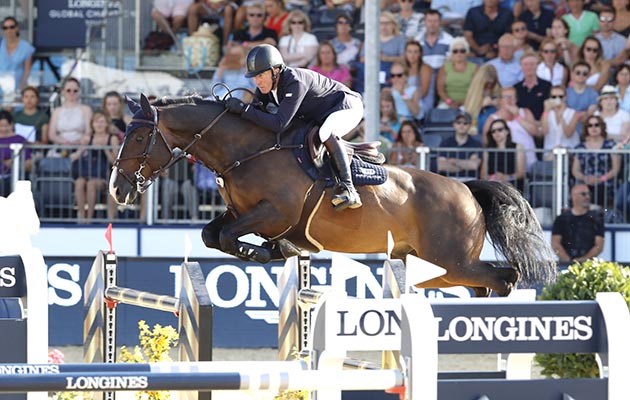The treble Hickstead Derby winner only began his partnership with Michael Whitaker as a teenager. Jennifer Donald charts the stocky gelding’s illustrious achievements and will to win
An all-star cast of horses has taken centre stage for Michael Whitaker during his four decades in the saddle, but one stands out for his longevity, consistency and magnificent conquests around the globe – Monsanta.
The stocky, Irish-bred “Monty” had a distinctive air about him with his trademark sheepskin noseband and unusually high head carriage. He could be sharp, but appreciated Michael’s quiet approach in the saddle and, driven by the Yorkshireman’s steely will to win, he tried his heart out at every obstacle.
The 13-year-old gelding was already a young rider European gold medallist and Queen’s Cup winner when Michael took over the reins, but the remarkable pair went on to land the Hickstead Derby three times in succession, plus four championship medals and some of the richest grands prix in the world. All this and he never suffered a day’s lameness in his life.
{"content":"PHA+4oCcRm9yIGFueSBiaWcgb2NjYXNpb24gaGUgd2FzIGEgdmVyeSBnb29kIGhvcnNlLOKAnSBzYXlzIE1pY2hhZWwuIOKAnE9uZSBvZiB0aGUgYmVzdCBpbiBmYWN0LuKAnTwvcD4KPHA+TW9uc2FudGHigJlzIHN0b3J5IGJlZ2lucyBpbiBOb3J0aGVybiBJcmVsYW5kIGluIHRoZSBtaWQgMTk3MHMsIHdoZXJlIGludGVybmF0aW9uYWwgcmlkZXIgTGVvbmFyZCBDYXZlIHByb2R1Y2VkIGhpbS48L3A+CjxwPjxkaXYgY2xhc3M9ImFkLWNvbnRhaW5lciBhZC1jb250YWluZXItLW1vYmlsZSI+PGRpdiBpZD0icG9zdC1pbmxpbmUtMiIgY2xhc3M9ImlwYy1hZHZlcnQiPjwvZGl2PjwvZGl2PjxzZWN0aW9uIGlkPSJlbWJlZF9jb2RlLTMxIiBjbGFzcz0iaGlkZGVuLW1kIGhpZGRlbi1sZyBzLWNvbnRhaW5lciBzdGlja3ktYW5jaG9yIGhpZGUtd2lkZ2V0LXRpdGxlIHdpZGdldF9lbWJlZF9jb2RlIHByZW1pdW1faW5saW5lXzIiPjxzZWN0aW9uIGNsYXNzPSJzLWNvbnRhaW5lciBsaXN0aW5nLS1zaW5nbGUgbGlzdGluZy0tc2luZ2xlLXNoYXJldGhyb3VnaCBpbWFnZS1hc3BlY3QtbGFuZHNjYXBlIGRlZmF1bHQgc2hhcmV0aHJvdWdoLWFkIHNoYXJldGhyb3VnaC1hZC1oaWRkZW4iPg0KICA8ZGl2IGNsYXNzPSJzLWNvbnRhaW5lcl9faW5uZXIiPg0KICAgIDx1bD4NCiAgICAgIDxsaSBpZD0ibmF0aXZlLWNvbnRlbnQtbW9iaWxlIiBjbGFzcz0ibGlzdGluZy1pdGVtIj4NCiAgICAgIDwvbGk+DQogICAgPC91bD4NCiAgPC9kaXY+DQo8L3NlY3Rpb24+PC9zZWN0aW9uPjwvcD4KPHA+4oCcSSBhY3R1YWxseSBzYXcgaGltIGp1bXBpbmcgYXMgYSBmaXZlLXllYXItb2xkIGluIElyZWxhbmQs4oCdIHJlY2FsbHMgTWljaGFlbC4g4oCcSGUgbG9va2VkIGNhcmVmdWwgZXZlbiB0aGVuIGFuZCBJIGZvbGxvd2VkIGhpcyBwcm9ncmVzcy7igJ08L3A+CjxwPldpdGggc29tZSBleGNlbGxlbnQgcmVzdWx0cywgaW5jbHVkaW5nIGEgYmlnIG1vbmV5IGdyYW5kIHByaXgsIHVuZGVyIGhpcyBiZWx0LCBMZW9uYXJkIHNlbnQgdGhlIHRoZW4gZWlnaHQteWVhci1vbGQgTW9uc2FudGEgdG8gbGVhZGluZyByaWRlciBKb2hubnkgR3JlZW53b29kIGluIEVuZ2xhbmQgdG8gc2VsbCwgYnV0IGl0IHdhcyBoaXMgZGF1Z2h0ZXJzIEdpbGxpYW4gKG5vdyBDYXRsb3cpIGFuZCBKdWxpZSAobm93IEFuZHJld3MpIHdobyB0b29rIHRoZSByZWlucyDigJMgYW5kIGRpZG7igJl0IGxldCBnb+KApjwvcD4KPHA+4oCcSGUgZm91bmQgdXMgcmVhbGx5LOKAnSBzYXlzIEdpbGxpYW4sIHRha2luZyB1cCB0aGUgdGFsZSBvZiBoZXIgaHVnZWx5IHN1Y2Nlc3NmdWwgdGltZSB3aXRoIHRoZSBnZWxkaW5nLjwvcD4KPGRpdiBjbGFzcz0iYWQtY29udGFpbmVyIGFkLWNvbnRhaW5lci0tbW9iaWxlIj48ZGl2IGlkPSJwb3N0LWlubGluZS0zIiBjbGFzcz0iaXBjLWFkdmVydCI+PC9kaXY+PC9kaXY+CjxwPuKAnEnigJlkIGJyb2tlbiBteSBhcm0sIHNvIEp1bGllIHJvZGUgaGltIHRocm91Z2hvdXQgdGhhdCBmaXJzdCB3aW50ZXIg4oCTIEkgZG9u4oCZdCB0aGluayBoZeKAmWQgZG9uZSBtdWNoIGluZG9vciBqdW1waW5nIGJlZm9yZSB0aGVuLuKAnTwvcD4KPHA+RWFybHkgaW4gMTk4NiwgMjAteWVhci1vbGQgR2lsbGlhbiB3YXMgYmFjayBpbiB0aGUgc2FkZGxlIGFuZCB0aGUgdHdvIHNpc3RlcnMgc2hhcmVkIHRoZSByaWRlIHRoYXQgeWVhci4gSnVsaWUgY29udGVzdGVkIHRoZSBqdW5pb3IgRXVyb3BlYW5zIG9uIE1vbnNhbnRhIHRoZW4gR2lsbGlhbiB3ZW50IG9uIHRvIHdpbiBnb2xkIGF0IHRoZSB5b3VuZyByaWRlcnMgRXVyb3BlYW4gQ2hhbXBpb25zaGlwcywgYXMgd2VsbCBhcyB0aGUgUXVlZW7igJlzIEN1cCBhdCB0aGUgUm95YWwgSW50ZXJuYXRpb25hbCBpbiAxOTg3LjwvcD4KPGRpdiBjbGFzcz0iYWQtY29udGFpbmVyIGFkLWNvbnRhaW5lci0tbW9iaWxlIj48ZGl2IGlkPSJwb3N0LWlubGluZS00IiBjbGFzcz0iaXBjLWFkdmVydCI+PC9kaXY+PC9kaXY+CjxwPuKAnEV2ZXJ5dGhpbmcgZmVsdCBzbyBlYXN5IG9uIGhpbSDigJMgaGUgY291bGQgZ28gZm9yIHdlZWtzIHdpdGhvdXQgaGF2aW5nIGEgZmVuY2UgZG93bizigJ0gc2F5cyBHaWxsaWFuLjwvcD4KPHA+U2hlIHdhcyBjb21wZXRpbmcgYXQgT2x5bXBpYSB3aGVuIGEgZGVhbCB3YXMgc3RydWNrIHRoYXQgd291bGQgdGFrZSB0aGlzIGVxdWluZSBzdGFyIGludG8gdGhlIGhhbmRzIG9mIG9uZSBvZiB0aGUgd29ybGTigJlzIGxlYWRpbmcgcmlkZXJzLiBMb3JkIEhhcnJpcywgbm93IGJlc3Qga25vd24gZm9yIGhpcyBvd25lcnNoaXAgb2YgU2NvdHQgQnJhc2jigJlzIGhvcnNlcywgaGFkIGp1c3Qgc3RhcnRlZCB0byBiYWNrIE1pY2hhZWwgV2hpdGFrZXIgYW5kIHdhcyBsb29raW5nIGZvciBhIGhvcnNlIHRvIHNlbmQgaGltLiBUaGUgZXF1YXRpb24gd2FzIHNvbHZlZCB0aGFua3MgdG8gRGF2aWQgQnJvb21lLjwvcD4KPGRpdiBjbGFzcz0iYWQtY29udGFpbmVyIGFkLWNvbnRhaW5lci0tbW9iaWxlIj48ZGl2IGlkPSJwb3N0LWlubGluZS01IiBjbGFzcz0iaXBjLWFkdmVydCI+PC9kaXY+PC9kaXY+CjxwPuKAnEhlIHNhaWQgYXQgT2x5bXBpYSBJIHNob3VsZCB3YXRjaCB0aGlzIGhvcnNlLOKAnSByZW1lbWJlcnMgTG9yZCBIYXJyaXMuIOKAnEkgd2VudCBkb3duIGFuZCBib3VnaHQgaGltIHN0cmFpZ2h0IGF3YXkuIEkga25ldyBoZSB3YXMgY2FyZWZ1bCBhbmQgaGUgaGFkIGEgbG90IG9mIGp1bXAsIGJ1dCBJIHByb2JhYmx5IGRpZG7igJl0IHRoaW5rIGhlIHdhcyBhcyBnb29kIGF0IHRoYXQgc3RhZ2UgYXMgaGUgcmVhbGx5IHdhcyDigJMgYnV0IHRoZW4gSSB0aG91Z2h0IHRoZSBzYW1lIGFib3V0IFNhbmN0b3MgdG9vIeKAnTwvcD4KPHA+TWljaGFlbCB3YXMgZnJpZW5kcyB3aXRoIHRoZSBHcmVlbndvb2QgZmFtaWx5IGFuZCBoYWQgZXZlbiBqdW1wZWQgTW9uc2FudGEgYXMgYSBjYXRjaCByaWRlIGF0IEdpam9uLCBTcGFpbiwgb25lIHllYXIuPC9wPgo8cD7igJxJIGhhZCBvbmx5IGdvbmUgdGhlcmUgdG8gd2F0Y2ggbXkgZmlyc3Qgd2lmZSwgVsOpcm9uaXF1ZSwganVtcGluZywgYnV0IEdpbGxpYW4gaGFkIGh1cnQgaGVyc2VsZizigJ0gcmVjYWxscyBNaWNoYWVsLiDigJxIZSB3ZW50IHZlcnkgd2VsbCBpbiB0aGUgZmlyc3QgY2xhc3MgYW5kIGZpbmlzaGVkIHNlY29uZCDigJMgdGhlbiBpbiB0aGUgbmV4dCBjbGFzcyBoZSBzdG9wcGVkIGFuZCBJIGZlbGwgb2ZmLiBJ4oCZbSBub3Qgc3VyZSB3aGF0IGhhcHBlbmVkLCBidXQgSSBvYnZpb3VzbHkgZGlkIHNvbWV0aGluZyB3cm9uZyBhbmQgd2VudCBmbHlpbmcgb3ZlciBoaXMgaGVhZCHigJ08L3A+CjxwPk1pY2hhZWzigJlzIG9ubHkgcmVzZXJ2YXRpb24gaW4gdGFraW5nIHRoZSByZWlucyBvbiBNb25zYW50YSB0aGlzIHRpbWUgd2FzIGhpcyBhZ2UuPC9wPgo8cD7igJxJIHdvbmRlcmVkIHdoZXRoZXIgYXQgdGhlIGFnZSBvZiAxMyBoZeKAmWQgc3RpbGwgYmUgYXMgZ29vZCzigJ0gTWljaGFlbCBwb25kZXJlZC4g4oCcQnV0IGhlIGNlcnRhaW5seSBwcm92ZWQgdGhhdCBoZSB3YXMuIEFnZSB3YXMganVzdCBuZXZlciBhbiBpc3N1ZSB3aXRoIGhpbS48L3A+CjxwPuKAnFdlIG1vcmUgb3IgbGVzcyBjbGlja2VkIHN0cmFpZ2h0IGF3YXkgYW5kIEkga25ldyBoZSB3YXMgYSBzZXJpb3VzIGhvcnNlLuKAnTwvcD4KPHA+TWljaGFlbCB0b29rIE1vbnR5IHN0cmFpZ2h0IG91dCBvbiB0aGUgV29ybGQgQ3VwIGNpcmN1aXQgYW5kIHdvbiB0aGUgQW50d2VycCBncmFuZCBwcml4IGF0IG9ubHkgdGhlaXIgc2Vjb25kIHNob3cgdG9nZXRoZXIuPC9wPgo8cD7igJxUaGVuIHdlIHdlbnQgdG8gR290aGVuYnVyZyBhbmQgaGUgd2FzIHNlY29uZCBpbiB0aGUgV29ybGQgQ3VwIGFuZCBzZWNvbmQgaW4gdGhlIGdyYW5kIHByaXgs4oCdIHNheXMgTWljaGFlbC4g4oCcSGUgbWFpbnRhaW5lZCB0aGF0IGNvbnNpc3RlbmN5IHRocm91Z2hvdXQgaGlzIGxpZmUgYWN0dWFsbHku4oCdPC9wPgo8cD5WZXJ5IHF1aWNrbHkgdGhlIGR1byB3ZXJlIGNvbnF1ZXJpbmcgZXZlcnkgY29ybmVyIG9mIHRoZSBnbG9iZS4gT25lIG9mIE1pY2hhZWzigJlzIHN0YW5kLW91dCBtb21lbnRzIGNhbWUgYXQgdGhlIDE5ODkgRXVyb3BlYW4gQ2hhbXBpb25zaGlwcyBpbiBSb3R0ZXJkYW0gd2hlcmUgdGhlIFdoaXRha2VyIGJyb3RoZXJzIHRvb2sgdGhlIGluZGl2aWR1YWwgZ29sZCBhbmQgc2lsdmVyIG1lZGFscywgYXMgd2VsbCBhcyBoZWxwaW5nIEdyZWF0IEJyaXRhaW4gdG8gdGVhbSBnb2xkLjwvcD4KPHA+4oCcSXQgd2FzIGEgcmVhbCBoZWFkLXRvLWhlYWQgYmV0d2VlbiBKb2huIGFuZCBtZSzigJ0gc2F5cyBNaWNoYWVsLCB3aG\/igJlkIHRvcHBlZCB0aGUgbGVhZGVyYm9hcmQgdGhyb3VnaG91dCwgYnV0IHdlbnQgdGhyb3VnaCB0byB0aGUgbGFzdCByb3VuZCBsZXNzIHRoYW4gYSBmZW5jZSBhaGVhZCBvZiA8YSBocmVmPSJodHRwczovL3d3dy5ob3JzZWFuZGhvdW5kLmNvLnVrL3RhZy9qb2huLXdoaXRha2VyIiB0YXJnZXQ9Il9ibGFuayIgcmVsPSJub29wZW5lciBub3JlZmVycmVyIj5Kb2huPC9hPiBvbiA8YSBocmVmPSJodHRwczovL3d3dy5ob3JzZWFuZGhvdW5kLmNvLnVrL3RhZy9taWx0b24iIHRhcmdldD0iX2JsYW5rIiByZWw9Im5vb3BlbmVyIG5vcmVmZXJyZXIiPk1pbHRvbjwvYT4uPC9wPgo8cD7igJxJIHdhcyBqdXN0IHRvbyBzbG93IHRvIGEgYmlnIG94ZXIgYW5kIE1vbnNhbnRhIGNsaXBwZWQgdGhlIGJhY2sgcmFpbCDigJMgaXQgd2FzIHRvdGFsbHkgbXkgZmF1bHQuIEJ1dCB0aGUgY29tYmluYXRpb24gd2FzIHJpZ2h0IGFmdGVyIGl0IHNvIEkgd2FzIHRyeWluZyBub3QgdG8gb3Zlci1yaWRlIHRoYXQuIFRoZW4gSSBsb3N0IG15IGNvbmNlbnRyYXRpb24gYW5kIGdhbGxvcGVkIGludG8gdGhlIGNvbWJpbmF0aW9uIGFuZCBoZSBqdW1wZWQgaXQgY2xlYXIgYW55d2F5LiBTbyBpdCBjb3VsZCBoYXZlIGJlZW4gYSB2ZXJ5IGRpZmZlcmVudCBzdG9yeSDigJMgaXQgd2FzIHNvIHVubHVja3kgaXQgd2FzIHVuYmVsaWV2YWJsZS4gQnV0IHRob3NlIGNoYW1waW9uc2hpcHMsIHdpdGggSm9obiBhbmQgbWUgZmlyc3QgYW5kIHNlY29uZCwgd2VyZSBicmlsbGlhbnQg4oCTIGl0IHdvdWxkIGhhdmUgYmVlbiBiZXR0ZXIgdGhlIG90aGVyIHdheSByb3VuZCwgbWluZCHigJ08L3A+CjxwPlRoYXQgc2FtZSB5ZWFyLCBNb25zYW50YSBhbmQgYSAyOS15ZWFyLW9sZCBNaWNoYWVsIGVudGVyZWQgdGhlIFNwcnVjZSBNZWFkb3dzIGhpc3RvcnkgYm9va3Mgd2hlbiB3aW5uaW5nIHRoZSB3b3JsZOKAmXMgcmljaGVzdCBwcml6ZSwgdGhlIER1IE1hdXJpZXIgYXMgaXQgd2FzIHRoZW4sIHRoZSBkYXkgYWZ0ZXIgaGVscGluZyBHcmVhdCBCcml0YWluIHdpbiB0aGUgZ3J1ZWxsaW5nIE5hdGlvbnMgQ3VwIGF0IHRoZSBDYW5hZGlhbiB2ZW51ZS4gVGhlIGp1bXAtb2ZmIGZvciBDYWxnYXJ54oCZcyB3aW5uZXLigJlzIHB1cnNlIOKAkyB3b3J0aCDCozk1LDAwMCBpbiB0b2RheeKAmXMgbW9uZXkg4oCTIHNob3djYXNlZCBNaWNoYWVsIGFuZCBNb25zYW50YSBhdCB0aGVpciBicmlsbGlhbnQsIGRhenpsaW5nIGJlc3QsIGluIGEgcm91bmQgZGVzY3JpYmVkIGFzIOKAnGV4cXVpc2l0ZeKAnSBieSB0aGUgY29tbWVudGF0b3IuPC9wPgo8cD7igJxIZSBhY3R1YWxseSB3b24gdGhlIEZyaWRheSBjbGFzcywgdGhlIE5hdGlvbnMgQ3VwIGFuZCB0aGUgYmlnIGNsYXNzIHRoYXQgeWVhcizigJ0gcmVjYWxscyBNaWNoYWVsLiDigJxDYWxnYXJ5IGlzIGJpZywgYnV0IGhlIGp1bXBlZCBjbGVhciBldmVyeSBkYXkg4oCTIHR3byByb3VuZHMgb24gRnJpZGF5LCB0d28gcm91bmRzIG9uIFNhdHVyZGF5IGFuZCB0aHJlZSBvbiBTdW5kYXkuPC9wPgo8cD7igJxIZSB3YXMgc28gcmVsaWFibGUgYW5kIGluIE5hdGlvbnMgQ3VwcyBoZSByYXJlbHkgaGFkIG1vcmUgdGhhbiBvbmUgZG93bjsgdGhlIGhhcmRlciB5b3UgdHJpZWQsIHRoZSBoYXJkZXIgaGUgdHJpZWQu4oCdPC9wPgo8cD5Nb25zYW50YSwgd2hvIGRvbm5lZCB0aGUgRXZlcmVzdCwgSGVuZGVyc29uIGFuZCBOZXh0IHByZWZpeGVzIG92ZXIgdGhlIHllYXJzIGluIGFjY29yZGFuY2Ugd2l0aCBNaWNoYWVs4oCZcyBzcG9uc29yc2hpcCBkZWFscywgd2FzIGFuIGVxdWFsbHkgYmlnIHdpbm5lciBpbmRvb3JzLCBidXQgaGlzIGFwdGl0dWRlIGZvciBhIHZhc3QgdHVyZiBhcmVuYSByZXN1bHRlZCBpbiB0aGVpciBoaXN0b3JpYyBIaWNrc3RlYWQgRGVyYnkgdHJlYmxlIGJldHdlZW4gMTk5MSBhbmQgMTk5My4gVGhlIHZldGVyYW4gZ2VsZGluZyBoYWQgYXJyaXZlZCBpbiBXZXN0IFN1c3NleCB0aGF0IGZpcnN0IHN1bW1lciBvZmYgdGhlIGJhY2sgb2YgYSBzbGlnaHRseSBkZWZsYXRpbmcgaW5kaXZpZHVhbCBwZXJmb3JtYW5jZSBhdCB0aGUgMTk5MSBFdXJvcGVhbiBDaGFtcGlvbnNoaXBzIGluIExhIEJhdWxlLCB3aGVyZSB0aGUgdGVhbSBoYWQgY29tZSBob21lIHdpdGggc2lsdmVyLjwvcD4KPHA+SG93ZXZlciwgdGhlIGZpcmUgd2l0aGluIHdhcyByZWlnbml0ZWQgYXJvdW5kIEhpY2tzdGVhZOKAmXMgaGFsbG93ZWQgdHVyZiBhbmQgdGhlIHBhaXIgc2VhbGVkIHZpY3Rvcnkgd2l0aCB0aGUgb25seSBjbGVhciByb3VuZCB0byB0aGUgZGVsaWdodCBvZiBhIHN1bi1kcmVuY2hlZCBjcm93ZC48L3A+CjxwPlRoZSBmb2xsb3dpbmcgeWVhciwganVtcGluZyB0b29rIHBsYWNlIGluIHN0YW1pbmEtc2FwcGluZywgcmFpbi1zb2FrZWQgY29uZGl0aW9uczxiciAvPgp0aGF0IE1pY2hhZWwgZGVzY3JpYmVzIGFzIOKAnG5lYXItaW1wb3NzaWJsZeKAnSBhbmQgbm9ib2R5IGNvdWxkIHByb2R1Y2UgYSBjbGVhci4gTWljaGFlbCBjYW1lIHRvIHRoZSBsYXN0IHdpdGgganVzdCBvbmUgcmFpbCBkb3duIGFuZCBvbiBsYW5kaW5nLCBhIHRpcmluZyBNb25zYW50YSDigJMgd2hvc2UgYm9vdHMgaGFkIGJlZW4gdHVybmVkIHVwc2lkZSBkb3duIGZyb20gaGlzIGVmZm9ydHMgaW4gdGhlIG11ZCDigJMgcGl0Y2hlZCBvbiBoaXMgbm9zZSwgaGF2aW5nIHN1bmsgaW50byB0aGUgZ3JvdW5kIOKAnHVwIHRvIGhpcyBmZXRsb2Nrc+KAnS4gVGhlIGdlbGRpbmcgaGFkIGdpdmVuIGhpcyBhbGwgYnV0IGNyb3NzZWQgdGhlIGxpbmUgZm9yIGEgc2Vjb25kIHN1Y2Nlc3NpdmUgdmljdG9yeTsgdGhlaXIgbmVhcmVzdCBjaGFsbGVuZ2VycyBoYWQgMTIgZmF1bHRzLjwvcD4KPHA+TW9uc2FudGEgaGFkIHRvIGRpZyBqdXN0IGFzIGRlZXAgaW4gMTk5MyB3aGVuIHRoZSBtb21lbnRvdXMgaGF0LXRyaWNrIHdhcyBhY2hpZXZlZCBhZnRlciBhIGp1bXAtb2ZmIGFnYWluc3QgQXVzdHJhbGlhbiBDaHJpcyBDaGFkd2ljayAoTXIgTWlkbmlnaHQpIGFuZCBGcmFuY2XigJlzIEhlcnbDqSBHb2RpZ25vbiAoUHJpbmNlIETigJlJbmNvdmlsbGUpLjwvcD4KPHA+4oCcSSBuZXZlciB1c2VkIHRvIHRyYWluIGZvciB0aGUgRGVyYnkg4oCTIEnigJlkIGp1c3QgdHVybiB1cCBhbmQgZ28g4oCTIGJ1dCBldmVuIGFmdGVyIE1vbnNhbnRhIHdvbiB0aGUgZmlyc3Qgb25lLCBJIGRpZG7igJl0IHRoaW5rIGhlIGhhZCBpdCBpbiBoaW0gdG8gY29tZSBiYWNrIGFuZCB3aW4gdGhlIGhhdC10cmljayzigJ0gcmVtZW1iZXJzIE1pY2hhZWwuIOKAnEJ1dCBoZSBqdW1wZWQgY2xlYXIgdGhyb3VnaCB0aGUgRGV2aWzigJlzIER5a2UgZXZlcnkgdGltZSBhbmQgbmV2ZXIgYmF0dGVkIGFuIGV5ZWxpZDsgaGUgbWFkZSB5b3UgZmVlbCB0b3RhbGx5IHNhZmUuIFRoYXQgd2FzIHRoZSB0aGluZyBhYm91dCBNb25zYW50YSwgd2hldGhlciBpdCB3YXMgSGlja3N0ZWFkLCBDYWxnYXJ5IG9yIER1YmxpbiwgaGUgbmV2ZXIgbGV0IHlvdSBkb3duLjwvcD4KPHA+4oCcV2lubmluZyBIaWNrc3RlYWQgdGhyZWUgdGltZXMgb24gdGhlIHRyb3Qgd2FzIHZlcnkgc3BlY2lhbC7igJ08L3A+CjxwPkFtb25nIE1vbnNhbnRh4oCZcyBvdGhlciBwaGVub21lbmFsIGF0dHJpYnV0ZXMgd2FzIGhpcyBzZW5zZSBvZiBvY2Nhc2lvbi48L3A+CjxwPuKAnFlvdSBjb3VsZCB0YWtlIGhpbSB0byB0aGUgbG9jYWwgc2hvdyBhbmQgaGUgY291bGQgaGF2ZSB0aHJlZSBmZW5jZXMgZG93biwgYnV0IGhlIGtuZXcgd2hlbiBpdCB3YXMgdGhlIGJpZyBkYXks4oCdIHNheXMgTWljaGFlbC4g4oCcSGUgd2FzIHNoYXJwLCBzbyB5b3UgaGFkIHRvIGdpdmUgaGltIHF1aXRlIGEgYml0IG9mIHdvcmsgdGhlIG1vcm5pbmcgYmVmb3JlIGEgY2xhc3MuIEhlIGNvdWxkIGdldCBhIGJpdCB0ZW5zZSwgYnV0IG9uY2UgeW914oCZZCBnb3QgaGltIHRvIHJlbGF4LCBoZSB3YXMgYXdheS4gSGUgd2FzIHRoZSBzYW1lIGF0IGhvbWUuIEJ1dCBoZSB3YXMgYWx3YXlzIHNvIGNhcmVmdWwg4oCTIEphbWVzIEZpc2hlciBqdW1wZWQgaGltIGF0IE9seW1waWEgb25lIHllYXIgYW5kIGhlIGp1bXBlZCBoaW0gY2xlYW4gb2ZmLCBoZSB3YXMgc28gY2FyZWZ1bCE8L3A+CjxwPuKAnEJ1dCBvbmUgdGhpbmcgYWJvdXQgaGltIHdhcyBoZSB3YXMgcXVpdGUgc3RvY2t5IHNvIGRpZCBoYXZlIGhpcyBqdW1waW5nIGxpbWl0IOKAkyBub3QgbWFueSBjb3Vyc2VzIHdlcmUgdG9vIGJpZyBmb3IgaGltLCBidXQgdGhlIEJhcmNlbG9uYSBPbHltcGljcyBmb3IgZXhhbXBsZSB3YXMganVzdCBzdHVwaWQgYmlnIGFuZCB0aGF04oCZcyBvbmUgdGltZSBJIHRob3VnaHQsIOKAmEJsb29keSBoZWxsLCBoZeKAmXMgZ29pbmcgdG8gc3RydWdnbGUgcm91bmQgaGVyZSzigJnigJ0gZXhwbGFpbnMgTWljaGFlbC4g4oCcSGUgYWN0dWFsbHkgb25seSBoYWQgb25lIGRvd24gaW4gZWFjaCByb3VuZCBvZiB0aGUgdGVhbSBjb21wZXRpdGlvbiwgYnV0IHdoZW4gaXQgZ290IHRvIHRoZSBzZWNvbmQgcm91bmQgb2YgdGhlIGluZGl2aWR1YWwsIGl0IHdhcyBqdXN0IHRvbyBiaWcuIEV2ZXJ5b25lIHN0cnVnZ2xlZCB0aG91Z2guPC9wPgo8cD7igJxPbmUgb2YgaGlzIGJlc3QgdHJhaXRzIHdhcyB0aGF0IGhlIHdvdWxkbuKAmXQgaG9sZCBhbnl0aGluZyBhZ2FpbnN0IHlvdSwgZXZlbiBpZiB5b3XigJlkIGNvY2tlZCBzb21ldGhpbmcgdXAs4oCdIGhlIGFkZHMuIOKAnEV2ZW4gYXQgdGhlIG5leHQgc2hvdyBhZnRlciB0aGUgT2x5bXBpY3MsIHdoZW4gaGXigJlkIGNyYXNoZWQgdGhyb3VnaCBhIGh1Z2UgY29tYmluYXRpb24gaW4gdGhlIGZpbmFsIHJvdW5kLCBoZSB3b24gYSBncmFuZCBwcml4LiBIZSBoYWQgc3VjaCBhIGdyZWF0IGF0dGl0dWRlLuKAnTwvcD4KPHA+VGhlIGRlY2lzaW9uIHdhcyBtYWRlIGJ5IHRoZSBvd25lcnMgTG9yZCBhbmQgTGFkeSBIYXJyaXMgdGhhdCB0aGUgdmV0ZXJhbiBzaG91bGQgcmV0aXJlLCB3aW4sIGxvc2Ugb3IgZHJhdywgYWZ0ZXIgaGlzIGZvdXJ0aCBIaWNrc3RlYWQgRGVyYnkgd2l0aCBNaWNoYWVsLiBUaGV5IGZpbmlzaGVkIHdpdGggZm91ciBmYXVsdHMgYWZ0ZXIgYSDigJxtaXggdXDigJ0gYXQgdGhlIEJhbmssIGJ1dCAxOS15ZWFyLW9sZCBNb25zYW50YSBoYWQgbG9zdCBub3RoaW5nIGluIGRlZmVhdC48L3A+CjxwPuKAnFRoYXQgd2FzIHRoZSBsYXN0IHRpbWUgSSByb2RlIGhpbSzigJ0gc2F5cyBNaWNoYWVsLiDigJxCdXQgSSB0aGluayB0aGUgSGFycmlzZXMgd2VyZSByaWdodCB0byBtYWtlIHRoZSBkZWNpc2lvbiB0aGVuIOKAkyBoZeKAmWQgaGFkIGFuIGFic29sdXRlbHkgZmFudGFzdGljIGNhcmVlci7igJ08L3A+CjxwPkRvZXMgTWljaGFlbCB3aXNoIGhlIGNvdWxkIGhhdmUgdGVhbWVkIHVwIHdpdGggaGlzIGV4Y2VwdGlvbmFsIHBhcnRuZXIgZml2ZSB5ZWFycyBlYXJsaWVyPzwvcD4KPHA+4oCcWWVzIEkgZG8g4oCTIGJ1dCBJIHdhcyBqdXN0IGdsYWQgdG8gaGF2ZSBnb3QgaGltIGF0IGFsbCzigJ0gaGUgcmVmbGVjdHMuIOKAnEl0IHdvcmtlZCBvdXQgdmVyeSB3ZWxsIGluIHRoZSBlbmQsIHNvIHBlcmhhcHMgaGUgbmVlZGVkIHRvIGdhaW4gdGhhdCBleHBlcmllbmNlIGJlZm9yZSBJIGdvdCBoaW0uIEhlIHdhc27igJl0IGxhbWUgdGhlIGVudGlyZSB0aW1lIEkgcm9kZSBoaW0sIHdoaWNoIGlzIGFtYXppbmcgd2hlbiB5b3UgY29uc2lkZXIgaGUgd2VudCBvbiB0byB0aGUgYWdlIG9mIDE5IOKAkyB0aGUgR3JlZW53b29kcyBvYnZpb3VzbHkgZGlkIGEgdmVyeSBnb29kIGpvYiBvZiBsb29raW5nIGFmdGVyIGhpbS7igJ08L3A+CjxwPlRoZSBncmVhdCBob3JzZSBzYXcgb3V0IGhpcyBkYXlzIHdpdGggTG9yZCBIYXJyaXPigJlzIGNvbXBhbnkgSFIgZGlyZWN0b3IsIENhcm9sIFNhd3llciwgZW5qb3lpbmcgZ3lta2hhbmFzIGFuZCBzaG93aW5nIGNsYXNzZXMuIEhlIGRpZWQgYWJvdXQgdGhyZWUgeWVhcnMgbGF0ZXIuIE5vdCBvbmx5IGRpZCBoZSBtYWtlIGhpc3RvcnkgYXMgb25lIG9mIHRoZSBtb3N0IHN1Y2Nlc3NmdWwgc2hvd2p1bXBlcnMsIGhlIHdpbGwgZm9yZXZlciBiZSByZW1lbWJlcmVkIHdpdGggZ3JlYXQgYWZmZWN0aW9uIGJ5IE1pY2hhZWwuPC9wPgo8cD7igJxFdmVyeSB0aW1lIEkgcm9kZSBhIGxhcCBvZiBob25vdXIgb24gTW9uc2FudGEg4oCTIG1vc3QgdGltZXMgSSBzYXQgb24gaGltLCBpbiBmYWN0IOKAkzxiciAvPgppdCBmZWx0IGxpa2UgdGhlIGJlc3QgZmVlbGluZyBpbiB0aGUgd29ybGQu4oCdPC9wPgo8aDM+4oCcQSBnb29kIGJsb2tl4oCdPC9oMz4KPHA+4oCcSSBoYWQgMTAwJSBmYWl0aCBpbiBteSBkYWQsIEpvaG5ueSBHcmVlbndvb2QsIHdobyBzcG90dGVkIHRoZSBwb3RlbnRpYWwgaW4gTW9uc2FudGEs4oCZIHNheXMgaGlzIGZvcm1lciByaWRlciBHaWxsaWFuIENhdGxvdyAobmXDqSBHcmVlbndvb2QpLiDigJxIZSB3YXMgcXVpdGUgc2hhcnAsIGJ1dCBoZSB3YXMgYWx3YXlzIHJlbGlhYmxlIHNvIHlvdSBmZWx0IGNvbXBsZXRlbHkgc2FmZSBvbiBoaW0gYW5kIGhlIHdhcyBhbiBhYnNvbHV0ZSBnZW50bGVtYW4gaW4gdGhlIHN0YWJsZS4gQnV0IGhlIGNvdWxkIGFic29sdXRlbHkgcnVuIGF3YXkgd2l0aCB5b3UsIHRvbyEgWW91IGhhZCB0byB0cmVhdCBoaW0gd2l0aCByZXNwZWN0IGF0IGFsbCB0aW1lcy4gSSB3b3VsZCBkZXNjcmliZSBoaW0gYXMgd29ya21hbmxpa2UsIHNvbGlkIGFuZCBzb3VuZCDigJQgaGUgZ290IG9uIHdpdGggdGhlIGpvYiBhbmQgd2FzIGp1c3QgYSBnb29kIHNvcnQgb2YgYmxva2UuPC9wPgo8cD7igJxXaW5uaW5nIHRoZSBRdWVlbuKAmXMgQ3VwIGF0IEJpcm1pbmdoYW0gb24gaGltIHdhcyBzdWNoIGEgaGlnaGxpZ2h0LiBPZiBjb3Vyc2UsIEkgZm9sbG93ZWQgaGlzIHByb2dyZXNzIHdpdGggTWljaGFlbCBhbmQgaXQgbWFkZSBtZSBzbyBwcm91ZC4gSSBoYXZlIGdyZWF0IG1lbW9yaWVzIOKAlCBpdCB3YXMgYW4gaG9ub3VyIHRvIHJpZGUgYSBob3JzZSBsaWtlIHRoYXQu4oCdPC9wPgo8aDM+4oCcU28gbWFueSBncmVhdCBvY2Nhc2lvbnPigJ08L2gzPgo8cD7igJxUaGUgcmVhbCBoaWdobGlnaHQgZm9yIG1lIHdhcyB3aW5uaW5nIHRoZSBIaWNrc3RlYWQgRGVyYnkgdGhyZWUgdGltZXMgcnVubmluZyzigJ0gcmVjYWxzIExvcmQgSGFycmlzLCBNb25zYW50YeKAmXMgY28tb3duZXIgd2l0aCBMYWR5IEhhcnJpcy4g4oCcQnV0IHdlIGhhZCBzbyBtYW55IGdyZWF0IG9jY2FzaW9ucyB3aXRoIGhpbSBhbmQgZm9yIGEgc21hbGwgaG9yc2Ug4oCUIGhlIHdhcyBvbmx5IDE2aGgg4oCUIGhlIHdhcyB1bmJlbGlldmFibGUuIFN1Y2ggYSB0cmllciBhbmQgYSByZWFsbHkga2luZCBob3JzZS48L3A+CjxkaXYgY2xhc3M9ImluamVjdGlvbiI+PC9kaXY+CjxwPuKAnUhlIHdvbiBhIGxvdCwgYnV0IEkgcHJlZmVyIG15IGhvcnNlcyB0byBqdW1wIHJlYWxseSB3ZWxsIGFuZCBmaW5pc2ggc2Vjb25kIHRoYW4gdG8gYmUgbHVja3kgYW5kIHdpbi4gTXkgd2lmZSB3YXMgdGhlcmUgZm9yIHRoZSBFdXJvcGVhbiBDaGFtcGlvbnNoaXBzIGluIFJvdHRlcmRhbSB3aGVuIGhlIGxlZCBvbiB0aGUgZmlyc3QgZGF5LCBsZWQgb24gdGhlIHNlY29uZCBkYXksIHRoZW4gSm9obiBhbmQgTWlsdG9uIGJlYXQgaGltIG9uIHRoZSB0aGlyZCBkYXkgYnkgb25lIGZlbmNlLjwvcD4KPHA+4oCcV2UgYWxzbyBoYWQgTWlkbmlnaHQgTWFkbmVzcyB3aXRoIE1pY2hhZWwgYXQgdGhhdCB0aW1lIOKAlCBib3RoIGdyZWF0IGhvcnNlcy4gSeKAmXZlIHdvbiBDYWxnYXJ5IHNldmVuIHRpbWVzLCBzbyBJ4oCZdmUgYmVlbiB2ZXJ5IGx1Y2t5IHdpdGggYWxsIHRoZXNlIGJyaWxsaWFudCBob3JzZXMu4oCdPC9wPgo8cD48ZW0+UmVmOiBIb3JzZSAmYW1wOyBIb3VuZDsgMyBEZWNlbWJlciAyMDIwPC9lbT48L3A+CjxwPgo="}
You may also be interested in:
The Olympic showjumper on learning from Harvey Smith, looking for the first fence and why, despite a tack room full
Credit: Julie Priestley
Here’s some top tips from the pair on how to introduce a horse to a new environment and build confidence…
Credit: Lucy Merrell
H&H’s showjumping columnist supports a bursary for show centres to upgrade facilities
H&H showjumping editor
Jennifer is passionate at showjumping and her role as H&H’s showjumping editor has taken her around the world reporting from shows and interviewing riders, connections and those involved behind the scenes. Since joining H&H from BBC Sport in 2005, she has written on every subject across the equestrian sphere — from turnout rugs to stable management — and has interviewed gold medallists, world champions and winners galore. She also has first-hand experience of working in the equestrian industry as a riding instructor and yard manager.





